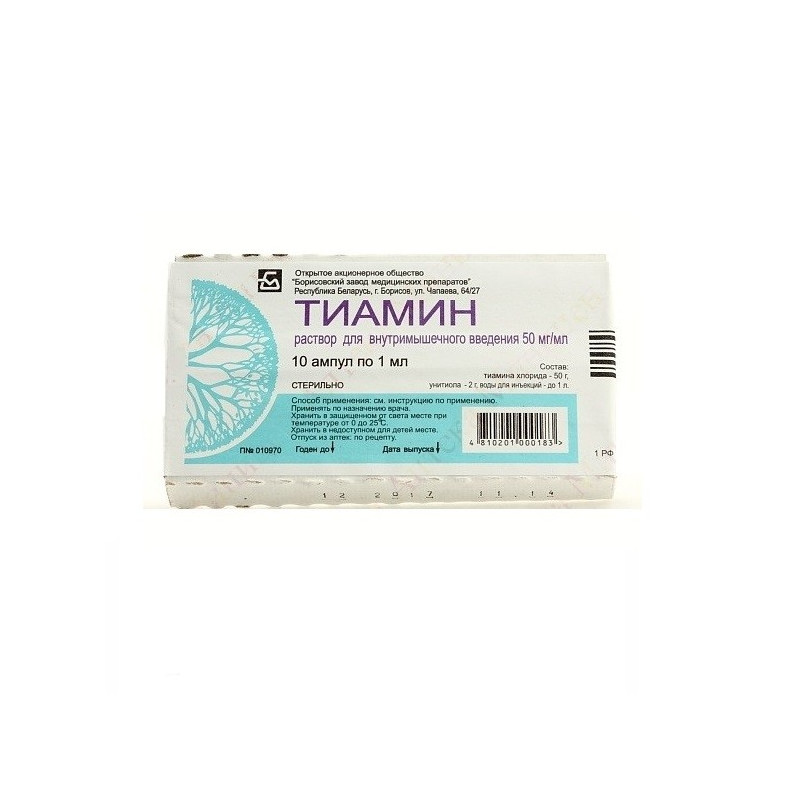



 All payments are encrypted via SSL
All payments are encrypted via SSL
 Full Refund if you haven't received your order
Full Refund if you haven't received your order
10 vials of 1 ml.
Thiamine plays an important role in the vital functions of the body, is part of a number of enzymes and is involved in carbohydrate metabolism, in the decarboxylation of a-keto acids and the synthesis of acetyl CoA. It has an impact on the conduct of nerve excitation in synapses, has ganglioblokiruyuschimi and curare-like properties. Of great importance for the function of the nervous system, digestive apparatus, cardiac activity, as well as the endocrine system. The source of thiamine for humans is food. In the absence or inadequate intake of food or in various conditions that prevent its absorption and absorption, the person develops the phenomenon of hypo-and avitaminosis B1. The initial stages of vitamin B1 deficiency are characterized by nervous disorders (neurasthenia, headaches, migraine, fatigue, insomnia, pain and sensitivity disorders in the limbs, muscle weakness, calf cramps), cardiovascular disorders (shortness of breath, expansion of the borders of the heart, rhythm disturbance) and digestive organs (anorexia,intestinal atony, constipation). Beriberi B1, called beriberi, occurs with either paralysis and exhaustion, or heart disease and edema. Thiamine, taken orally, is absorbed in the small intestine, partially undergoing inactivation of the thiaminase.
Hypovitaminosis and avitaminosis B1, incl. in patients on probe nutrition, hemodialysis, with malabsorption syndrome. The complex therapy includes neuritis and polyneuritis, radiculitis, neuralgia, peripheral paresis and paralysis, Wernicke's encephalopathy, Korsakov’s psychosis, chronic liver damage, various intoxications, myocardiodystrophy, impaired coronary blood circulation, peptic ulcer and 12 duodenal ulcer, atonic disease, atonic ulcer, atonic dyspnea, atonic dyspnea intestines; thyrotoxicosis, diabetes mellitus, endarteritis; dermatosis (eczema, atopic dermatitis, psoriasis, lichen planus) with neurotrophic changes and metabolic disorders; pyoderma.
Hypersensitivity.
Intramuscularly (deep into the muscle). It is recommended to begin parenteral administration with small doses (no more than 0.5 ml of a 5% or 2.5% solution) and only with good tolerability higher doses are administered. Adults appoint 0.02 - 0.05 g of thiamine chloride (1 ml of 2.5 or 5% solution) once a day, every day; 0.0125 g (0.5 ml of a 2.5% solution) of thiamine chloride is administered to children. The course of treatment - 10 - 30 injections.
Allergic reactions (urticaria, pruritus, angioedema, rarely - anaphylactic shock), sweating, tachycardia. Rare pain (due to the low pH of the solutions).
Parenteral administration is recommended only if ingestion is not possible (nausea, vomiting, malabsorption syndrome, preoperative or postoperative conditions). In Wernicke's encephalopathy, dextrose should be preceded by taking thiamine.
The solution of thiamine chloride should not be mixed with solutions containing sulfites, because in them it completely disintegrates. Simultaneous parenteral administration of thiamine with Pyridoxine or cyanocobalamin is not recommended: pyridoxine makes it difficult to convert thiamine to a biologically active form, cyanocobalamin enhances the allergic action of thiamine. Thiamine and penicillin or streptomycin (destruction of antibiotics), thiamine and nicotinic acid (destruction of thiamine) should not be mixed in the same syringe. Weakens the effect of depolarizing muscle relaxants (suxamethonia iodide, etc.).
Store in a dry place at a temperature not exceeding 25 ° C, in places inaccessible to children.
Thiamine chloride